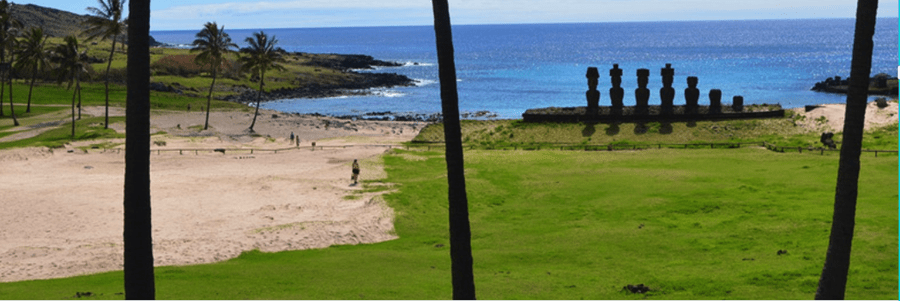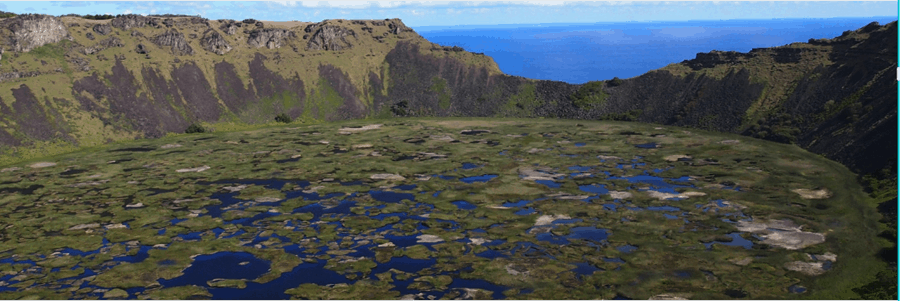Follow us in the footsteps of the island’s first recorded European visitor, Jacob Roggeveen, the Dutch explorer who encountered it on Easter Sunday (5 April) in 1722 – hence the name.
Find out why this mystical island is a bucket list item for many travellers, the best time to go and how to get there.
why visit easter island?
The fascination with Easter Island lies firstly in its utter remoteness, being one of the most remote inhabited islands in the world. It belongs to Chile and sits in the Pacific Ocean 2182 miles away from the Chile mainland and 1289 miles from the nearest inhabited island of Pitcairn. To set foot on Easter Island is to have experienced one of the most isolated places on the planet.
This remoteness was one of the major factors that led to the development of a unique civilization on the island, the Rapa Nui. One of the most remarkable things about the Rapa Nui civilization is how they carved some 900 massive statues, those iconic Easter Island works of art known as Moai, and transported them around the island. In fact, Easter Island itself is known locally as Rapa Nui.
Secondly, are the ongoing mysteries that surround the moai and their creators. How did the original settlers reach this remote island? What do the moai represent? How were these vast creations moved into place? Why are there no trees?
With no written and little oral history in existence on the island, it’s impossible to be certain. A few wooden tablets enscribed with the ancient islanders language, rongo-rongo remain scattered in museums but slave raids in the 1860’s meant all able-bodied men were taken, among them all the wise men who knew how to read and write rongo-rongo. Since then, no one knows how to interpret the tablets. Several linguists have tried, but there is no generally accepted theory of how to read the symbols.

what to see and do on easter island
the moai
Rapa Nui’s mysterious moai statues stand in silence but speak volumes about the achievements of their creators. Carved from volcanic rock, they average 13 feet (4 meters) tall and 14 tons. The effort to construct these monuments and move them around the island must have been considerable—but no one knows exactly why the Rapa Nui people undertook such a task. Most scholars suspect that the moai were created to honour ancestors, chiefs, or other important personages.
The population is thought to have thrived between the 10th and 16th centuries erecting around 900 statues. All have bodies even though some are submerged and appear as just heads.
Ahu Tongariki is the most spectacular platform of Easter Island. Its isolated location, the nearby Poike volcano and the waves of the Pacific Ocean crashing behind it, give an air of majesty and mystery unmatched. Watching the sunrise behind its 15 moais, oriented to Rano Raraku volcano, is unforgettable. Tahai, near Hanga Roa, is possibly the best place to watch the sunset after a hectic day. The set of three ahus is located in a peaceful meadow waterfront where to watch the sunset behind the statues.
Rano Raraku
This extinct volcano crater is the site of the quarry where most of the moai were sculpted and is a remarkable sight. Dozens of statues remain, a few standing, some fallen and some unfinished still attached to the mother rock from which they were being hewn.
Anakena Beach
On Easter Island there are only three beaches, but undoubtedly, the beach of Anakena is “the beach” on the island. Surrounded by lush palm trees brought from Tahiti, fine white sand and crystal clear waters, it is the perfect spot to relax (complete with moais).
surfing
Few people know that the sport of surfing has played just a significant a role in the island’s history. When the early settlers sailed to Rapa Nui from Polynesia, life on the lost island was all about living off the sea, and evidence indicates that crude surfboards were constructed for travel and fishing. But it was only in the early 1990s that the island found its way onto the surfing radar. In-the-know pros have been coming ever since to try their luck on some of the largest and most gratifying waves in the world.
The best time of year to surf on Rapa Nui is during the island’s summer months – January and February – when the crystalline sea rolls in under a cloudless sky. There is also snorkelling, scuba diving, sailing, kayaking and horse riding to enjoy.
rapa nui dances
It is strongly recommended to attend one of the several shows at Hanga Roa, the island’s urban centre, where the typical dances of Easter Island are shown. The dances offered are really authentic and although they are aimed at tourists, are also intended as a way to preserve the ancient culture and making young islanders to know and love their heritage.
The Tapati Rapa Nui, is the most important cultural festival of Easter Island and is celebrated every year during the first two weeks of February. A unique opportunity to enjoy and learn about ancient sports, crafts, live music, dancing and a grand finale parade.
hiking and cycling
Because the island is so small (just a tiny triangle of land 14 miles long and 7 miles wide with an extinct volcano at each of the three corners) and relatively flat along the coast it’s great fun to explore on bicycle and just enjoy the scenery.
Rano Kau is the highest volcano of the three and the peak can be reached on foot via the Ara o Te Ao hiking trail starting just outside Hanga Roa. it also takes in the Orongo Ceremonial Village. This village gained significance during the later part of the island’s history due to the emergence of the birdman cult. Each spring, Easter Island tribes sent a representative to try to obtain the first egg of the Sooty Tern bird which nests on the islets just off the coast. The winner became the leader of the entire island for the next year. Important members of society temporarily moved to Orongo to oversee the competition.
To learn more about the hike itself take a look at this great blogpost
stargazing
As you can imagine, somewhere this isolated presents perfect conditions for stargazing. Join a local expert tour and head out to some of the island’s traditional observatory sites to gaze at the night sky and view stars and constellations visible only in the Southern Hemisphere. A great opportunity for that dazzling instagram post!

When To Go and How to Get There
when to go
Easter Island is an all year round destination but the summer months with the best weather and clearest waters are January to March. The beginning of February offers the additional opportunity of catching the Tapati Rapa Nui festival – a vibrant celebration of the island’s culture which is an annual highlight.
However these are therefore also the busiest months (although busy on Easter Island is not the same as busy in Venice!) so you might want to consider travelling either side of this season for a more isolated experience with the milder weather.
how to get there
Getting to Easter Island is usually by plane from Chile’s capital, Santiago and a trip would generally form part of the itinerary for a tour of Chile/Argentina. It is worth bearing in mind that it is a six hour flight from mainland Chile so you might want to consider this when deciding how long to stay. Hopefully our list of things to do says it’s worth lingering longer to immerse yourself in the magic rather than simply ticking a box.
Another option is to visit as part of a cruise in the area. Silversea offer a spectacular opportunity to spend a few days on Easter Island before joining their 14 night expedition cruise of the South Pacific Islands. From Easter Island you wend your way to Tahiti via the Pitcairn Islands and French Polynesia (including Bora Bora) on board the Silversea Explorer.

For more Easter Island inspiration:
- Watch Rapa-Nui a 1994 film based on Rapa Nui legends of Easter Island, in particular the race for the sooty tern’s egg in the Birdman Cult.
- Watch 180 Degrees South, a documentary film following Jeff Johnson as he retraces the epic 1968 journey of his heroes Yvon Chouinard and Doug Tompkins to Patagonia. Along the way, he gets shipwrecked off Easter Island, surfs the longest wave of his life — and prepares himself for a rare ascent of Cerro Corcovado.
- Listen to Kris Kristofferson’s Easter Island from the eponymous album.
- See a real moai statue at the British Museum


